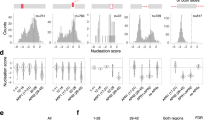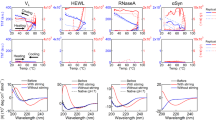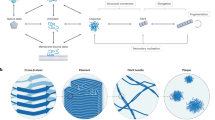Abstract
In order for any biological system to function effectively, it is essential to avoid the inherent tendency of proteins to aggregate and form potentially harmful deposits1,2,3,4. In each of the various pathological conditions associated with protein deposition, such as Alzheimer's and Parkinson's diseases, a specific peptide or protein that is normally soluble is deposited as insoluble aggregates generally referred to as amyloid2,3. It is clear that the aggregation process is generally initiated from partially or completely unfolded forms of the peptides and proteins associated with each disease. Here we show that the intrinsic effects of specific mutations on the rates of aggregation of unfolded polypeptide chains can be correlated to a remarkable extent with changes in simple physicochemical properties such as hydrophobicity, secondary structure propensity and charge. This approach allows the pathogenic effects of mutations associated with known familial forms of protein deposition diseases to be rationalized, and more generally enables prediction of the effects of mutations on the aggregation propensity of any polypeptide chain.
This is a preview of subscription content, access via your institution
Access options
Subscribe to this journal
Receive 51 print issues and online access
$199.00 per year
only $3.90 per issue
Buy this article
- Purchase on Springer Link
- Instant access to full article PDF
Prices may be subject to local taxes which are calculated during checkout


Similar content being viewed by others
References
Kopito, R. R. Aggresomes, inclusion bodies and protein aggregation. Trends Cell Biol. 10, 524–530 (2000)
Kelly, J. W. The alternative conformations of amyloidogenic proteins and their multi-step assembly pathways. Curr. Opin. Struct. Biol. 8, 101–106 (1998)
Rochet, J. C. & Lansbury, P. T. Jr Amyloid fibrillogenesis: Themes and variations. Curr. Opin. Struct. Biol. 10, 60–68 (2000)
Carriò, M. M. & Villaverde, A. Construction and deconstruction of bacterial inclusion bodies. J. Biotech. 96, 3–12 (2002)
Dobson, C. M. Protein misfolding, evolution and disease. Trends Biochem. Sci. 24, 329–332 (1999)
Sunde, M. & Blake, C. The structure of amyloid fibrils by electron microscopy and X-ray diffraction. Adv. Protein Chem. 50, 123–159 (1997)
Liemann, S. & Glockshuber, R. Influence of amino acid substitutions related to inherited human prion diseases on the thermodynamic stability of the cellular prion protein. Biochemistry 38, 3258–3267 (1999)
Hammarstrom, P., Wiseman, R. L., Powers, E. T. & Kelly, J. W. Prevention of transthyretin amyloid disease by changing protein misfolding energetics. Science 299, 713–716 (2003)
Chiti, F. et al. Kinetic partitioning of protein folding and aggregation. Nature Struct. Biol. 9, 137–143 (2002)
Chiti, F. et al. Studies of the aggregation of mutant proteins in vitro provide insights into the genetics of amyloid diseases. Proc. Natl Acad. Sci. USA 99, 16419–16426 (2002)
Dobson, C. M. Getting out of shape. Nature 418, 729–730 (2002)
Giasson, B. I., Murray, I. V., Trojanowski, J. Q. & Lee, V. M. A hydrophobic stretch of 12 amino acid residues in the middle of α-synuclein is essential for filament assembly. J. Biol. Chem. 276, 2380–2386 (2001)
Azriel, R. & Gazit, E. Analysis of the minimal amyloid-forming fragment of the islet amyloid polypeptide. An experimental support for the key role of the phenylalanine residue in amyloid formation. J. Biol. Chem. 276, 34156–34161 (2001)
Sakagashira, S. et al. S20G mutant amylin exhibits increased in vitro amyloidogenicity and increased intracellular cytotoxicity compared to wild-type amylin. Am. J. Pathol. 157, 2101–2109 (2000)
Salmona, M. et al. Molecular determinants of the physicochemical properties of a critical prion protein region comprising residues 106–126. Biochem. J. 342, 207–214 (1999)
Thompson, A. J., Barnham, K. J., Norton, R. S. & Barrow, C. J. The Val-210-Ile pathogenic Creutzfeldt-Jakob disease mutation increases both the helical and aggregation propensities of a sequence corresponding to helix-3 of PrP(C). Biochim. Biophys. Acta 1544, 242–254 (2001)
Conway, K. A. et al. Acceleration of oligomerization, not fibrillization, is a shared property of both alpha-synuclein mutations linked to early-onset Parkinson's disease: Implications for pathogenesis and therapy. Proc. Natl Acad. Sci. USA 97, 571–576 (2000)
Van Nostrand, W. E., Melchor, J. P., Cho, H. S., Greenberg, S. M. & Rebeck, G. W. Pathogenic effects of D23N Iowa mutant amyloid β-protein. J. Biol. Chem. 276, 32860–32866 (2001)
Miravalle, L. et al. Substitutions at codon 22 of Alzheimer's abeta peptide induce diverse conformational changes and apoptotic effects in human cerebral endothelial cells. J. Biol. Chem. 275, 27110–27116 (2000)
Nilsberth, C. et al. The ‘Arctic’ APP mutation (E693G) causes Alzheimer's disease by enhanced Aβ protofibril formation. Nature Neurosci. 4, 887–893 (2001)
Esler, W. P. et al. Point substitution in the central hydrophobic cluster of a human β-amyloid congener disrupts peptide folding and abolishes plaque competence. Biochemistry 35, 13914–13921 (1996)
Gamblin, T. C., Berry, R. W. & Binder, L. I. Tau polymerization: Role of the amino terminus. Biochemistry 42, 2252–2257 (2003)
Barghorn, S. et al. Structure, microtubule interactions, and paired helical filament aggregation by tau mutants of frontotemporal dementias. Biochemistry 39, 11714–11721 (2000)
Gamblin, T. C. et al. In vitro polymerization of tau protein monitored by laser light scattering: Method and application to the study of FTDP-17 mutants. Biochemistry 39, 6136–6144 (2000)
Nacharaju, P. et al. Accelerated filament formation from tau protein with specific FTDP-17 missense mutations. FEBS Lett. 447, 195–199 (1999)
Li, L., Von Bergen, M., Mandelkow, E. M. & Mandelkow, E. Structure, stability, and aggregation of paired helical filaments from tau protein and FTDP-17 mutants probed by tryptophan scanning mutagenesis. J. Biol. Chem. 277, 41390–41400 (2002)
Symmons, M. F., Buchanan, S. G., Clarke, D. T., Jones, G. & Gay, N. J. X-ray diffraction and far-UV CD studies of filaments formed by a leucine-rich repeat peptide: Structural similarity to the amyloid fibrils of prions and Alzheimer's disease β-protein. FEBS Lett. 412, 397–403 (1997)
Orpiszewski, J. & Benson, M. D. Induction of beta-sheet structure in amyloidogenic peptides by neutralization of aspartate: A model for amyloid nucleation. J. Mol. Biol. 289, 413–428 (1999)
Street, A. G. & Mayo, S. L. Intrinsic β-sheet propensities result from van der Waals interactions between side chains and the local backbone. Proc. Natl Acad. Sci. USA 96, 9074–9076 (1999)
Bucciantini, M. et al. Inherent toxicity of aggregates implies a common mechanism for protein misfolding diseases, Nature 416, 507–511 (2002)
Acknowledgements
We thank M. Calamai, J. Zurdo and M. Vendruscolo for critical reading of the manuscript. The Dipartimento di Scienze Biochimiche in Florence is supported by the Italian MIUR (Progetto “Genetica Molecolare” and Progetto FIRB “Folding di proteine: l'altra metà del codice genetico”). We are grateful for support from the Wellcome Trust (F.C. and C.M.D.).
Author information
Authors and Affiliations
Corresponding author
Ethics declarations
Competing interests
The authors declare that they have no competing financial interests.
Supplementary information
41586_2003_BFnature01891_MOESM1_ESM.doc
Supplementary Information 1: In this table we report the scales of hydrophobicity, β-sheet propensity and charge for the 20 natural amino acids. These values are necessary for calculating the terms of δHydr, (δδGcoil-β + δδGα-coil) and δCharge to be used in equation 1. Further details are given in the caption to Table 1. (DOC 24 kb)
41586_2003_BFnature01891_MOESM2_ESM.doc
Supplementary Information 2: In this section we describe how the experimental data from the literature were used to determine the experimental values of ln (vmut/vwt) for each of the mutations reported in Table 1. The reader should also refer to the Methods section. (DOC 32 kb)
Rights and permissions
About this article
Cite this article
Chiti, F., Stefani, M., Taddei, N. et al. Rationalization of the effects of mutations on peptide andprotein aggregation rates. Nature 424, 805–808 (2003). https://doi.org/10.1038/nature01891
Received:
Accepted:
Issue Date:
DOI: https://doi.org/10.1038/nature01891
This article is cited by
-
Amyloid aggregates induced by the p53-R280T mutation lead to loss of p53 function in nasopharyngeal carcinoma
Cell Death & Disease (2024)
-
Amyloidogenic proteins in the SARS-CoV and SARS-CoV-2 proteomes
Nature Communications (2023)
-
Characterization of Plasma SDS-Protein Aggregation Profile of Patients with Heart Failure with Preserved Ejection Fraction
Journal of Cardiovascular Translational Research (2023)
-
p53 amyloid aggregation in cancer: function, mechanism, and therapy
Experimental Hematology & Oncology (2022)
-
Proteome-wide landscape of solubility limits in a bacterial cell
Scientific Reports (2022)
Comments
By submitting a comment you agree to abide by our Terms and Community Guidelines. If you find something abusive or that does not comply with our terms or guidelines please flag it as inappropriate.



